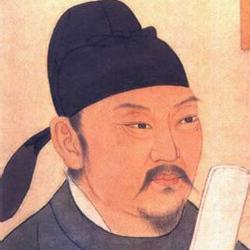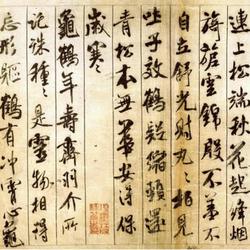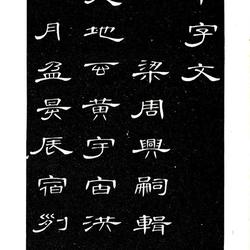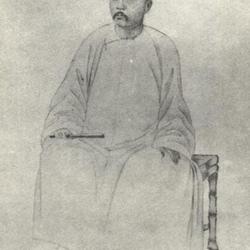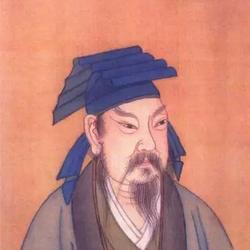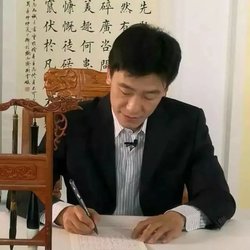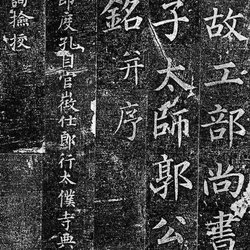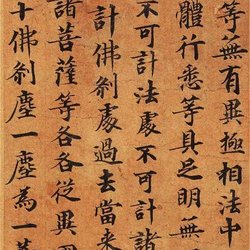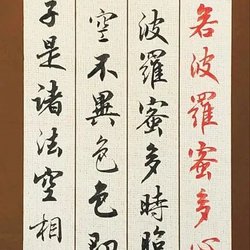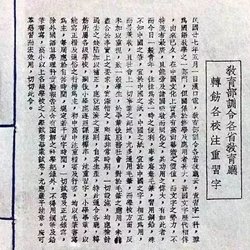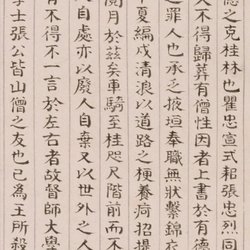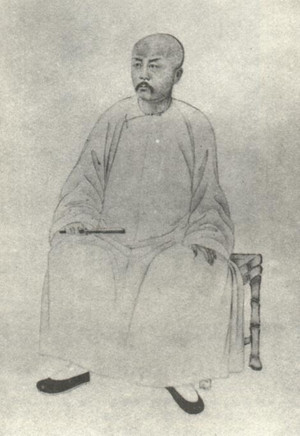
Zhao Zhiqian (1829-1884) was born in Shaoxing, Zhejiang. The first name was Yifu, and the nickname was Lengjun; later the name was changed to Lushu, and the names were Tiesan, Hanliao, Bei'an, Wumen, Mei'an, etc. He lived in "Erjindietang" and "Kujianshi". He served as magistrate of Poyang and Fengxin counties in Jiangxi Province. He was good at poetry and prose, and was good at calligraphy. He first studied with Yan Zhenqing, and used seal script and official script with Deng Shiru. Later he became his own style, stubborn and powerful. Stay out of fashion. He was good at painting, and his flowers were modified after imitating Shi Tao. He was the pioneer of freehand flowers in the late Qing Dynasty. He first learned seal cutting from the Zhejiang School, followed the seals of the Qin and Han Dynasties, and then joined the Song, Yuan and Anhui schools. He obtained Qin imperial edicts, Han mirrors, coins, Han inscriptions and stele texts, etc. for printing. He swept away old habits and made his works green and powerful. In his youth, he became famous all over the world for his talent. His attainments in calligraphy are multi-faceted, and he can integrate Zhen, Cao, Li and Zhuan brushwork into one, complementing each other and complementing each other. Zhao Zhiqian once said: "Independence is precious, the world is huge, many people say it, and independence is hard to find." He made unremitting efforts in poetry, calligraphy, painting and art throughout his life, and finally became a master of his generation. One of the sixty Shanghai schools in the late Qing Dynasty.
Due to his superb artistic achievements, artists centered in Shanghai, especially the new generation such as Wu Changshuo, were influenced by Zhao Zhiqian and gradually formed a new school - Shanghai style painting. Pan Tianshou wrote in "History of Chinese Painting": "Zhao Zhiqian, the uncle of Kuaiji, painted flowers with the interest of calligraphy and painting in stone, grand and ancient, and was the first of the Qianhai School." In fact, Zhao Zhiqian's influence was not limited to the sea, Qi Baishi Northern masters such as Chen Shizeng and Chen Shizeng were also influenced by him.
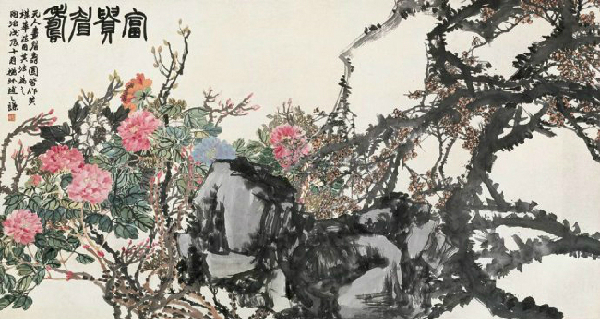
Rich Eyebrows and Longevity Lens, color on paper, by Tongzhi Wuchen (1868) (24.08 million yuan, Shanghai Hengli, April 2010)
This "Picture of Rich Eyebrows and Longevity", if we say it is "gorgeous", it means that the "gorgeous" is ancient, it is "gorgeous" rather than "rich", coupled with the "strong and thick" brushwork, it is really Pan The word "Hongsi Guli" mentioned by Tianshou is very suitable to describe Zhao's floral style. "The Picture of Wealthy Eyebrows and Longevity" is a large banner with a very imposing composition. The strokes start from the upper right corner and end at the lower left corner, forming a diagonal layout. The title is in the upper left part of the painting, and there are two small vermilion seals, which play the role of the finale. This diagonal composition method is more common in Zhao's large banner paintings. Zhao Zhiqian was a master of seal cutting and had extraordinary abilities in arranging seal patterns. From sealing to painting, his painting composition ability was naturally also outstanding. The four-character inscription "Wealth, Honor, Eyebrows and Longevity" is written in seal script. The inscription in seal script and official script can make the work more rich in gold and stone. This is another characteristic of Zhao's flower works in his later period. "Strong and thick" is also a characteristic of the brushwork used in this work, especially the plum blossoms on the right. Although he himself said that he used Yuanren's method to create it, his brushwork was entirely due to the stele. Such a majestic structure, and such a vivid expression of vitality, would definitely not be possible without the lines of the stele. The publicity of "power" is an important aesthetic feature of Zhao's large-scale masterpieces. Very few people can express this kind of power, even in the freehand paintings of Xu Wei and Shi Tao, let alone Wu (Chang Shuo), Qi (Bai Shi), etc. In addition to his extraordinary writing skills, Fugui Meishou's composition is also unique. The branches are sometimes intertwined and sometimes separated. The dense areas form a strong contrast with the large blank spaces. This kind of "sparse and airtight" layout It actually comes from his sealing method, which is also the composition method he often uses to paint plum blossoms. "Wealthy Eyebrows and Longevity" is one of the most important works among Zhao Zhiqian's handed down works. It is not only huge in size, but also a masterpiece of his personal style.
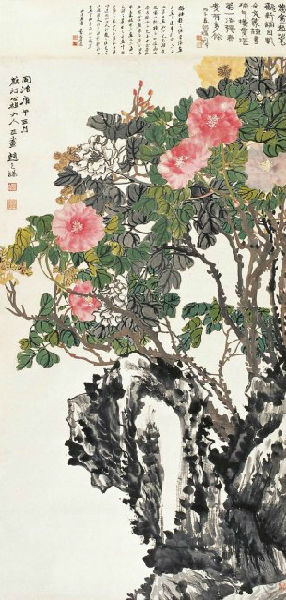
Dafugui (6.944 million yuan, Beijing Rongbao in May 2010)
This "Peony Picture" is an eye-catching work, rare in its exquisiteness and large-scale composition. In this work, calligraphy and painting are integrated, the lines are mastered with precision, and the brush strokes are crisp and sophisticated. In particular, the mountains and rocks outlined are rough and thick, and are full of "gold and stone spirit". The flowers in the painting have lush branches and leaves, presenting a thriving scene. It is clear that Zhao Zhiqian broke through the stereotypes of his predecessors in terms of composition. He often likes to place the main parts and titles at the top of the painting, which is still like the interest of Bada Shanren. The inscription is "In the third month of Gengwu, Tongzhi, Lord Ou Ting Gongzu is painting. Zhao Zhiqian." At that time, the word "Gongzu" was an honorific title for those with higher social status. It is not difficult to see that this should be Zhao Zhiqian's masterpiece. The "Ou Ting" in the painting is Guo Ou Ting, the great-grandfather of Guo Weiqu. He had a close friendship with Zhao Zhiqian and also liked to collect calligraphy and paintings. As the national flower, the peony is a symbol of wealth. The author used peonies in the painting and gave them to his friends of many years, and his beautiful words are fully revealed through the painting.

Picture of Wealth and Honor Banner by Jiashen (1884)
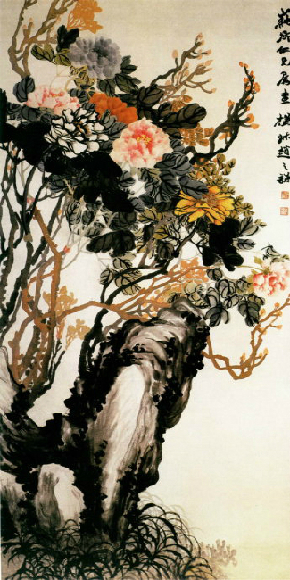
Peony painting, vertical scroll, color on paper
The use of beautiful rocks and blooming peonies in paintings has always been a favorite subject of painters. This peony painting by Zhao Zhiqian fully reflects his unique style of color application and brushwork. The lake stone hooks are round and strong. The peony is depicted using both Yun Shouping's boneless painting method and the outline and coloring method. The two painting methods are unified in the dignified and thick brushwork. Make good use of red, black, green and other heavy colors in color application, and seek harmony in contrast to make the picture rich and lively. The pen and ink are solid and the colors are bright. Contrary to its elegant and noble style, it achieves an artistic effect that is appreciated by both refined and popular people.



Picture of wind and lotus, vertical scroll, picture of Tongxia Lake stone, picture of crape myrtle making the weather clear, vertical scroll

Lotus, vertical scroll, color on paper (3.92 million yuan, Beijing Hanhai, December 2010)
作为一个文人画家,赵之谦的绘画作品具有文人画的特点,即画中有诗,诗画结合,蕴含着深厚文学内涵;在绘画传统的“神形兼备”中,更重神似,摒弃纯粹自然地模拟客观对象,强调写意,竭力表达作者的主观因素、思想感情和秉性气质,尤其追求作品的书卷气、士气,即所谓高雅脱俗的文人风度。在技法上,讲究笔情墨趣,纳书法于画法,以书法的表现力融于绘画之中。他的画常常用夸张的手法,赋予花草以性格。赵之谦画荷,为了突出荷花的性格,表现其“出淤泥而不染,濯清涟而不妖,中通外直,不蔓不枝”的特性。此幅作品采取了极为夸张的手法,取立幅,竖绘荷茎,挺拔向上,从纸底直至纸顶,上端着两朵荷花,相互呼应。婷婷俊秀。几乎充满画面,下疏上密,下虚上实,从而鲜明且突出地渲染了荷花在峰头怒放的姿态,表现出卓而不群的傲气。其实,此幅荷花也是画家自我,心灵的写照。从结构到运笔,都大胆而独特,出奇制胜。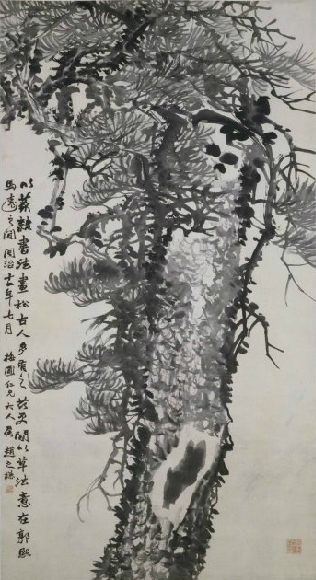
墨松图 立轴纸本 1872年作
据画家自题,此图参用了篆、隶、草三体的书写技法来描绘松树,落笔圆浑滋厚,与作者的书法风格同一格调。树干、枝条、松针以草书笔法表现,秉承了文人画豪放洒脱的传统。画上行书落款笔力雄健遒劲,其金石韵味与松木的画法相映衬,意趣横生。此幅不愧为赵之谦以金石、书法入画的代表作。
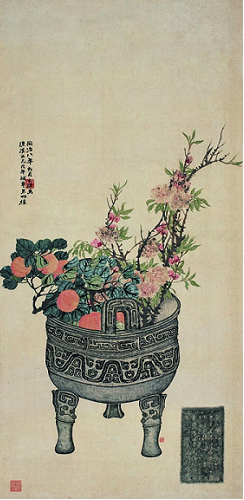
花果图 设色纸本 镜片 1869年作
在商周吉金拓片上作画并不鲜见,但是要表现得和谐雅致却不容易。首先对拓家的要求极高,拓家得有视觉概括的本事,用最简单同时也是最充分的手段抓住器物的特征制模,在同一平面上加以表现,使拓片所含信息最大化。而且要艺术地表现,上纸上墨乃至对纸张伸缩的把握都要做到胸有成竹,使所拓有素描的明暗效果,如此方能传神。鼎在中国古代是礼之重器,是别上下、明贵贱,标志统治权力和等级的器物,其型稳重,其饰华丽,其立面构成复杂,所以拓古鼎尤为难,但是,拓得好其纸上呈现不输名家画作。清代乾嘉以来,金石碑学大兴,以此为业者代不乏人,金石书画家们也纷纷上手,比如王小松、邓石如都擅此道。
此作六皆拓片,赵之谦补花卉,所拓为商代晚期古鼎。六皆是咸丰同治年间杭州著名的吉金拓家,赵之谦的朋友。此作款曰“同治八年九月之谦为练溪五兄同年补花果两种。”同治八年即1869年,当时赵之谦正从北京南归客居杭州,故此画作于杭州。“练溪”胡姓,也是赵之谦的朋友。在拓片上作画,既不能压抑所拓器物,也不能掩饰自己的表现。赵之谦就擅长张扬个性。而在古鼎拓片上作画,他非但落笔不滞疑,且无一笔误,将花卉果枝从古鼎中生发,透视一律,盎然有生气。果实大小疏密,花枝长短错落,乃至设色浓淡素艳,不仅顾及了古鼎的器型,也顾及了鼎身的纹饰,相互映带,和谐统一。赵之谦属于那种眼既高手亦高的艺术家,其绘画不受媒材和形式限制。

异鱼图 手卷 设色纸本 1861年作 (1150万元,2011年12月西泠秋拍)
赵之谦画《异鱼图》,设色纸本横卷,纵35.4厘米,横222.5厘米,画各种赵之谦以前见所未见,闻所未闻的海中生物,计有沙噀、章拒、锦魟、海豨、剑鲨、鬼蟹、虎蟹、马鞭鱼、琴虾、竹夹鱼、胡阑、骰子鱼、燕魟,共计15种。落款曰:“咸丰辛酉,撝叔客东瓯,见海物有奇形怪状者,杂图此纸,间为考证名义,传神阿堵,意在斯乎。” 钤白文印“赵氏之谦”。此图胡澍题引首,费念慈题笺,另有江湜、刘焞、陈宝善题跋,历经徐子静、刘世珩、林熊光等人递藏。时年赵之谦33岁。
《异鱼图》为晚清画苑奇葩,构图丰富和谐,异鱼15种虽参差向背,大小各异,却能疏密交错,繁而不乱,笔笔相生、物物相需,有一气呵成之势。造型准确生动,小者如马鞭鱼,大者如海豨,繁者如八足章鱼,均取象写意,极富生气。而鬼蟹、琴虾等最小者,绘者亦能准确生动地随笔而出,现其肥美鲜活之态。设色清雅明净,其中沙噀、锦魟等以深浅赭石以没骨叠色渍染而成,浓淡深浅,曲尽其妙。而海豨、燕魟则以水墨皴擦烘染之法成之,层次分明,极具质感。此图所画异鱼,不论大小,其下必有考证题识,所书小中见大,精气内敛,颇具金石气,此题既为广见闻,资考订,足备一方物产之资料,也是书画相合联通此卷全局的重要纽带。
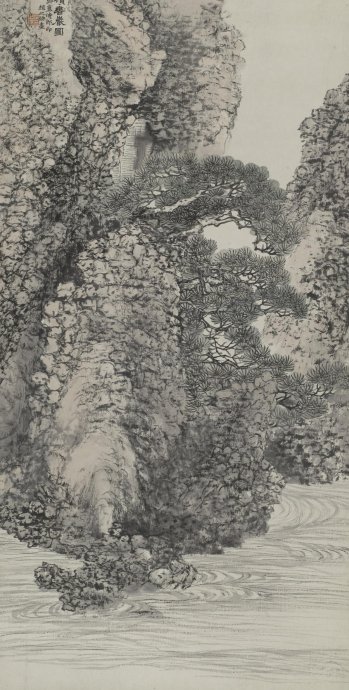
积书崖图
款识:积书岩图。郑盦侍郎命赵之谦画。钤印:赵之谦印(白文方印)
赵之谦的画,山水所见不多,偶现一二,亦颇具个性。该作品取材于河北层山积书岩的景色,崖脚下碧波荡漾,陡直的峭壁险峻无路,石崖间青松盘曲,苍翠欲滴。山腰上缀有洞窟一穴,洞内有天然横坚交错的石纹,远望状如堆积书卷的藏书库,赋予无限的生机和情趣。墨韵神采俱佳,工致中有透着帅气。
画史上,一说郑盦为赵之谦的契友沈树镛;另有一说,郑盦为赵之谦的朋友潘祖荫。这是因为潘、沈二人都是赵氏在京师交往的友人,且其斋名相近,又都是著名的收藏家。但因潘氏更注重对金石、图书的收藏,且曾任侍郎之职,故推断本画极有可能是赵之谦为潘氏所创作的。
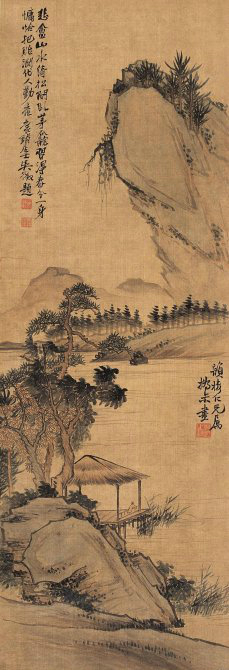
闲庭看山图 立轴 设色绢本
This picture is a work made by Zhao Zhiqian when he was forty years old, which was the period when Zhao Zhiqian's art matured. His works also had a growing reputation. He also used calligraphy to write landscapes, which are broad and honest, and blended with ink and wash. It can match Xu Wei, Shi Tao, and Li, and has a unique appearance. This painting was originally collected by Li Jiafu, and it is even more rare because it was appraised and inscribed with poems by the famous landscape artist Wu Daiqiu (Li Jiafu's son-in-law).
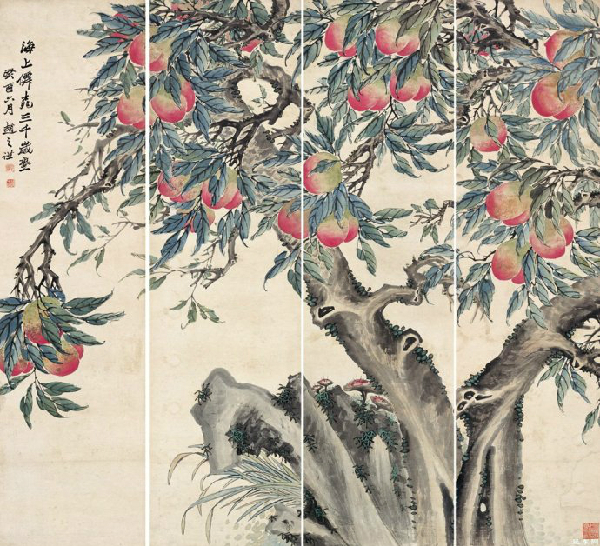
Picture of Fairy Peach on the Sea, panoramic screen, color on paper, 1873
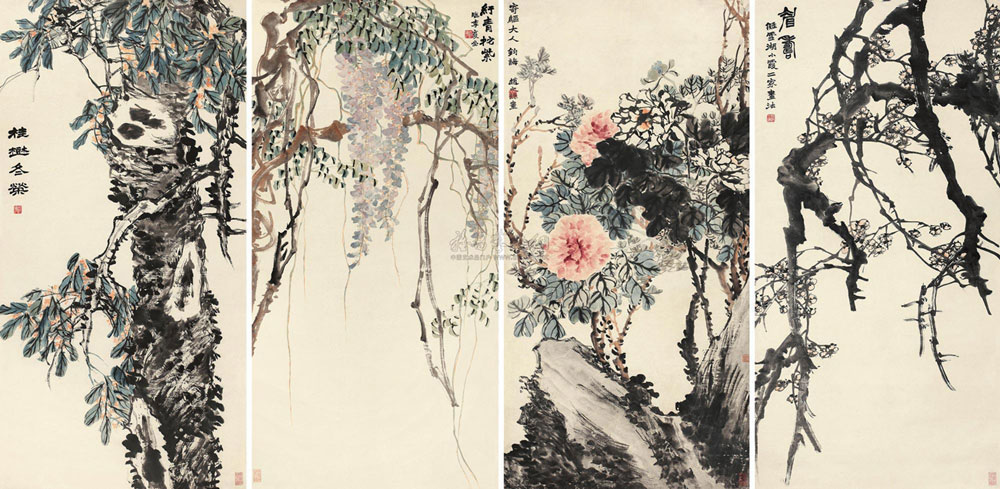
Flowers, four screens, color on paper (6.0632 million yuan, Sotheby’s Autumn Auction in Hong Kong, October 2005)
This secondary hall screen is the largest among Zhao Zhiqian's handed down works. A limited number of his paintings have been circulated, and the four screens recorded in the data are even rarer. If every frame of the hall screen is all four feet wide like this copy, there is no one in a hundred. It should be customized and specially painted by the artist. become. The hall screen is painted with peonies, wisteria, red plums and osmanthus trees respectively. The titles of the two frames are taken from each other. The red plum sun is modeled after the Xuehu and Xiaoxia families, namely Liu Shiru and Shen Xiang in the late Ming Dynasty. Both of them were good at writing plum blossoms and had a master-disciple relationship. The wisteria is modeled after Li Wei. Although Yun Shi is a predecessor, he has already combined his own appearance, such as the red plum with the vigorous and strange stones, and the twists and turns of the lines with the meaning of seal script and official brushwork; the wisteria uses the pen to turn randomly, smooth and freehand, showing the unrestrained and unrestrained; the osmanthus uses thick ink and light ink alternately The texture effect of the tree trunks is brought out by the chapped brush, the shape is simple and astringent, and unique and interesting; the peony, longevity and graphite colors are blended together, and the brush and ink are bold and vigorous, showing a strong and old-fashioned spirit. The whole work is a mixture of powerful metalwork and freehand brushwork, which shows the artist's concentration!

Tongyin Qiuyue, vertical scroll, color on paper (3.472 million yuan, published in Beijing in November 2010)
Zhao Zhiqian's painting of trees does not rely on the strength of his brush strokes, but rather uses the shape and posture of the trunk to express the tree's bending but not bending, bending but not bowing, and the old and vigorous spirit. This painting "Autumn Moon in the Shade of Tung Trees" depicts a towering tung tree, breaking through the picture, and a persevering character emerges vividly on the page. Traditional literati paintings are good at dividing ink into five colors. Since the middle of the Qing Dynasty, many literati painters have begun to try to mix colors and ink in their paintings. How to play the role of color in freehand paintings without losing the elegance of literati has become a new challenge faced by literati painters in the late Qing Dynasty. In this painting, Zhao Zhiqian's colors and inks blend freely, using green grass to represent the tung leaves, ocher to represent the buds, and garcinia to represent the autumn moon. Especially the treatment of the tung tree trunk is a masterpiece. First, light ink is used to distinguish the yin and yang of the trunk, and then garcinia is used to moisturize the part. Then, thick ink is used to paint the tree moss, and the whole trunk is blended with color and ink.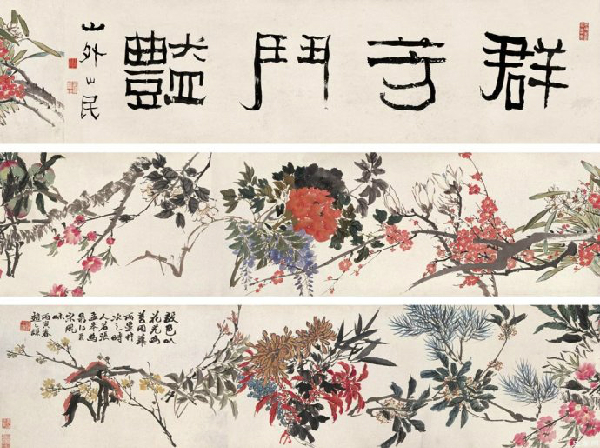
The beauty of beauty, hand scroll, color on paper
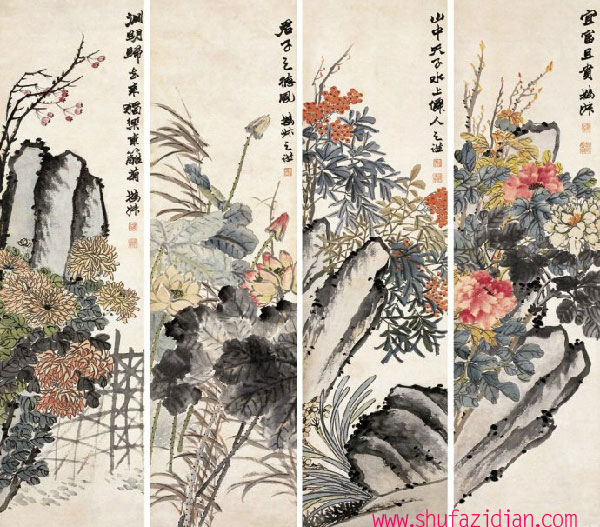
Guihe Xianshou Four Screens (3.3 million yuan, Shanghai Zhongtian, July 2005)
These four screens are naturally designed to pray for longevity and wealth. The words used in the title and title are elegant and thoughtful. None of the paintings are signed with year marks, which seems to be difficult for Lu to do his best. Therefore, it is relatively pure and elegant, and the atmosphere of books is better than that of metal and stone. It is definitely a rare treasure.
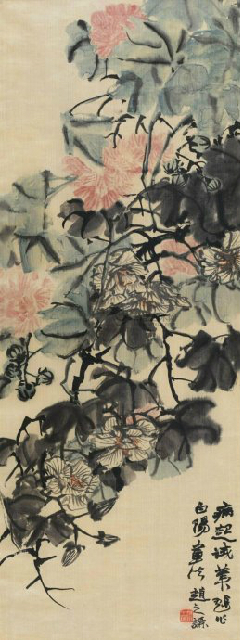
Furong, ink and color on silk, frame (3.32 million yuan, China Guardian, November 2011)
The flowers in Zhao Zhiqian's paintings are based on ivy and white sun, and are influenced by Futang's painting style. He integrates seal cutting and calligraphy into the paintings. Therefore, the pen and ink are bold and unrestrained, and the ink and color are blended. They are gorgeous but without losing the simple and heavy atmosphere. It is very The charm of gold and stone. Although this painting is said to be "a test of brushstrokes due to illness", the composition is naturally tight, with red flowers and green leaves interlaced, making it eye-catching, which shows that it is full of energy, and the straight lines are as straight as a hair, which is vivid and vivid. Written in the Aya edition, it is extremely rare.
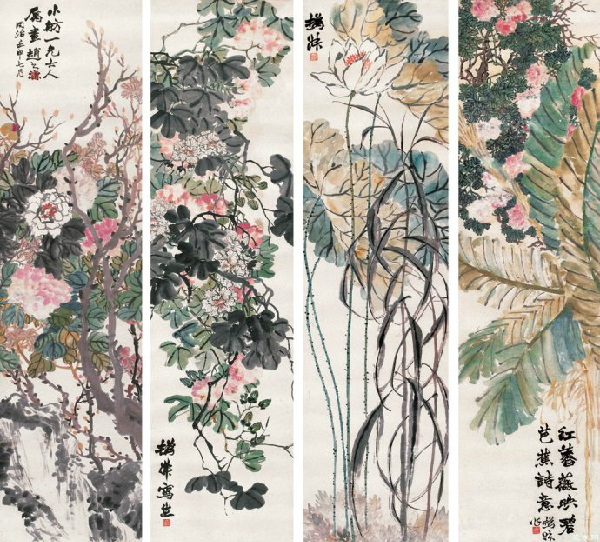
Flowers, four panels, color on paper, by Ren Shen (1872)




Fruits of the Four Seasons, screen, color on paper
Zhao Zhiqian's heavy-color freehand flower paintings skillfully combine the brush and ink techniques of literati freehand painting with the coloring principles of Ming and Qing Dynasty's mixed-color freehand flower and black paintings, making them unique and unique. These four screens can be described as his masterpiece. The flowers, fruits and trees painted are rich and colorful in brush and ink. The contrast between density and density in the composition is strong, and the calligraphy on the inscription is also crude and thick, so its style is rich in gold and stone and has a strong personality. The title of one screen: "The biography of hundreds of sons and thousands of houses and wonderful trees, receiving the prime minister's record for ten years. Pseudo uncle." The title of the second screen: "We will live forever for thousands of years. Uncle." The title of the third screen: "The real flowers hang in the autumn, and the rich gold is always there. Midstream. Worked by Uncle Ruo." The title of the four screens is: "Don't hold up the strong man's fist, but hold the Tathagata's arm. Tan Chan faces the sky dragon, and realizes that it is not a finger. Zhiqian is a painting of Lord Zi Pei. In December of the ninth year of Tongzhi. "
There are so many masterpieces by Zhao Zhiqian, let’s start with these!

